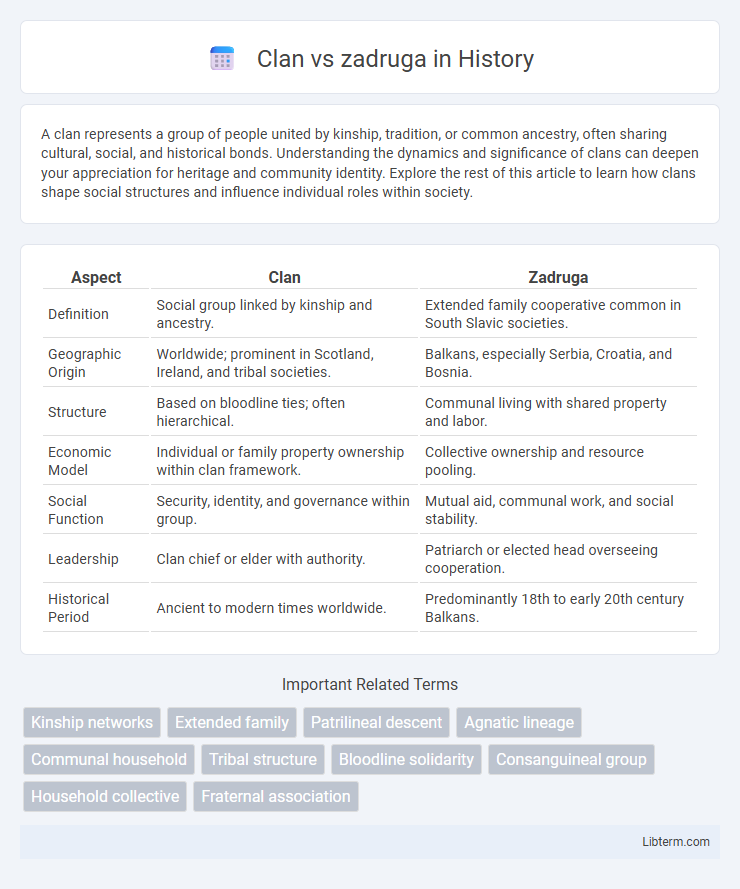A clan represents a group of people united by kinship, tradition, or common ancestry, often sharing cultural, social, and historical bonds. Understanding the dynamics and significance of clans can deepen your appreciation for heritage and community identity. Explore the rest of this article to learn how clans shape social structures and influence individual roles within society.
Table of Comparison
| Aspect | Clan | Zadruga |
|---|---|---|
| Definition | Social group linked by kinship and ancestry. | Extended family cooperative common in South Slavic societies. |
| Geographic Origin | Worldwide; prominent in Scotland, Ireland, and tribal societies. | Balkans, especially Serbia, Croatia, and Bosnia. |
| Structure | Based on bloodline ties; often hierarchical. | Communal living with shared property and labor. |
| Economic Model | Individual or family property ownership within clan framework. | Collective ownership and resource pooling. |
| Social Function | Security, identity, and governance within group. | Mutual aid, communal work, and social stability. |
| Leadership | Clan chief or elder with authority. | Patriarch or elected head overseeing cooperation. |
| Historical Period | Ancient to modern times worldwide. | Predominantly 18th to early 20th century Balkans. |
Understanding the Concept of Clan
A clan is a social group consisting of people united by actual or perceived kinship and descent, often sharing a common ancestor and a collective identity. Unlike the zadruga, which is a communal family-based cooperative primarily focused on shared economic activities and land management, clans emphasize lineage, cultural heritage, and social hierarchy. Clans function as fundamental units of social organization in many traditional societies, maintaining internal cohesion through rituals, customs, and mutual support.
What is a Zadruga?
A Zadruga is a traditional South Slavic communal family structure where multiple generations live and work together on shared land, emphasizing collective ownership and mutual support. Unlike a clan, which is often based on kinship ties and social affiliations, a Zadruga functions as an economic and social unit managing resources cooperatively. This system historically enabled agricultural efficiency and social cohesion in rural communities of the Balkans.
Historical Origins: Clan vs Zadruga
Clans originated as kinship-based social structures primarily found in Scottish and Irish history, functioning to unite families under a common ancestor and territorial domain. The zadruga, rooted in South Slavic traditions, was a collective family farming community emphasizing joint property ownership and cooperative labor among extended family members. Both systems reflect distinct cultural adaptations to social organization and resource management in their respective historical regions.
Social Structure and Organization
Clans consist of extended family groups united by kinship ties, often led by a chief or elder who maintains authority through hereditary or consensual means. Zadrugas represent communal living arrangements prevalent in South Slavic cultures, organized around collective ownership of land and shared responsibilities among multiple families, fostering cooperation and mutual support. Both social structures emphasize strong internal bonds but differ significantly, with clans prioritizing lineage-based hierarchy and zadrugas focusing on egalitarian communal organization.
Roles and Responsibilities in Each System
In a clan system, roles and responsibilities are primarily centered around kinship ties, with leadership often vested in a chieftain or elder who mediates disputes, oversees resource allocation, and upholds social norms. In contrast, the zadruga system, traditionally found in South Slavic communities, emphasizes collective family labor and shared ownership, where decisions are made communally under the guidance of the eldest male, who coordinates agricultural work, property management, and mutual support among members. Both systems rely on strong familial bonds but differ in their organizational structure and the distribution of duties within the group.
Economic Function: Clan and Zadruga Compared
Clans and zadrugas serve distinct economic functions within their communities, with clans primarily focused on maintaining kinship ties and social cohesion, while zadrugas operate as collective family units managing shared agricultural production and resources. In zadrugas, economic activities like farming, livestock raising, and property ownership are communal, promoting efficiency and resource pooling for survival and prosperity. Clans emphasize inheritance and social obligations, which sustain economic alliances but lack the fully integrated cooperative management found in zadrugas.
Decision-Making Processes
Clan decision-making processes typically emphasize consensus among family elders and rely on informal customs that prioritize unity and respect for tradition. Zadruga structures incorporate collective decision-making where members participate more democratically, often holding assemblies to discuss and resolve community issues. This participatory approach in zadrugas promotes shared responsibility and accountability compared to the hierarchical nature of clan governance.
Impact on Community Cohesion
Clans foster strong loyalty and identity within smaller, tight-knit family groups, often creating deep-rooted social bonds that enhance local trust and mutual support. Zadrugas, as larger communal groups, promote collective ownership and shared responsibilities, which can improve resource management and social welfare but may dilute individual family influence. The impact on community cohesion varies as clans emphasize exclusive kinship ties while zadrugas encourage broader cooperative networks.
Modern Relevance and Transformation
Clans traditionally function as kinship-based social units with shared ancestry, while zadrugas represent extended family communities with collective ownership and cooperative labor, primarily found in the Balkans. In modern times, clans have transformed into socio-political networks that influence identity, business, and leadership structures, whereas zadrugas are being revived as models for sustainable rural development and cooperative economics. The contemporary relevance of both lies in their adaptive capacity to preserve cultural heritage while addressing community resilience and social cohesion.
Clan vs Zadruga: Key Differences and Similarities
Clan and Zadruga both represent traditional social structures emphasizing kinship and communal living but differ significantly in organization and scope. A Clan is typically a group of families united by a common ancestor, often with a flexible leadership and dispersed settlements, while a Zadruga is a cooperative family unit found mainly in the Balkans, characterized by a single household or compound where extended family members share resources and labor. Both emphasize collective responsibility and mutual support, yet the Clan often extends beyond a single location, whereas the Zadruga functions as an integrated economic and social entity within a shared dwelling.
Clan Infographic

 libterm.com
libterm.com